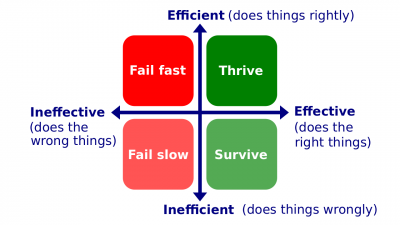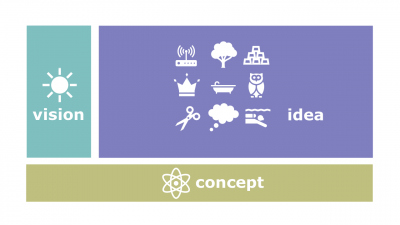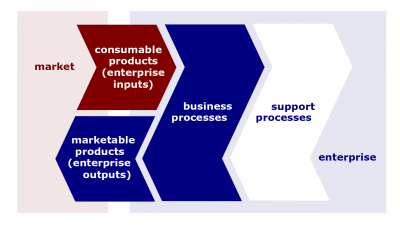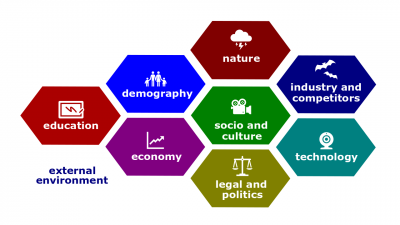Difference between revisions of "Idea Generation Quarter"
(→Concepts) |
(→Concepts) |
||
| Line 36: | Line 36: | ||
#*[[Business threat]]. Something like a software vulnerability that may be harmful for a [[business]]. | #*[[Business threat]]. Something like a software vulnerability that may be harmful for a [[business]]. | ||
#'''[[Stressor origin]]'''. The point or place either in the [[external environment|external]] or [[internal environment]], where the cause for a [[change]] originates, arises, or is derived. | #'''[[Stressor origin]]'''. The point or place either in the [[external environment|external]] or [[internal environment]], where the cause for a [[change]] originates, arises, or is derived. | ||
| − | #*[[Internal environment]]. (1) Those [[factor]]s and forces inside of somebody or something that affect or can potentially affect his, her, or its performance; (2) [[ | + | #*[[Internal environment]]. (1) Those [[factor]]s and forces inside of somebody or something that affect or can potentially affect his, her, or its performance; (2) [[Enterprise environment]] within the borders of the [[enterprise]]. |
| − | #*[[File:External-environment.png|400px|thumb|right|[[External environment]]]][[External environment]]. (1) Those [[factor]]s and forces outside of somebody or something that affect or can potentially affect his, her, or its performance; (2) [[ | + | #*[[File:External-environment.png|400px|thumb|right|[[External environment]]]][[External environment]]. (1) Those [[factor]]s and forces outside of somebody or something that affect or can potentially affect his, her, or its performance; (2) [[Enterprise environment]] beyond the borders of the [[enterprise]]. |
#'''[[Business need]]'''. Something that is necessary for a [[business]] in order to be carried on. | #'''[[Business need]]'''. Something that is necessary for a [[business]] in order to be carried on. | ||
#*[[Market supply]]. The part of the [[market]] that represents the total quantity of a [[product]] that all producers are willing and able to provide on a certain [[market segment]] at a certain price during a certain period of time. Another part is [[market demand]], which absolutely depends on the ''supply''. | #*[[Market supply]]. The part of the [[market]] that represents the total quantity of a [[product]] that all producers are willing and able to provide on a certain [[market segment]] at a certain price during a certain period of time. Another part is [[market demand]], which absolutely depends on the ''supply''. | ||
Revision as of 00:47, 23 May 2018
Idea Generation Quarter (hereinafter, the Quarter) is a lecture introducing the learners to portfolio discovery primarily through key topics related to idea generation. The Quarter is the first of four lectures of Portfolio Quadrivium, which is the first of seven modules of Septem Artes Administrativi (hereinafter, the Course). The Course is designed to introduce the learners to general concepts in business administration, management, and organizational behavior.
Contents
Outline
No predecessor lecture is available. This Quarter is the first lecture of the Quadrivium, which is the first module of the Course.
- Portfolio discovery is the enterprise discovery of data needed to design or modify the enterprise portfolio. Established enterprises must have one of more operational businesses (i.e. those businesses that generate revenue). Any enterprise can also possibly launch one or more startup businesses (i.e. those businesses that haven't generate revenue and yet rely on the external funds). The enterprise portfolio is a combination of operational and/or startup businesses.
- Organizationally, the data needed to design or modify the enterprise portfolio is collected through idea generation, validated learning, monitoring, and/or market engagements. This particular lecture concentrates on idea generation because these enterprise efforts are the primary method for identifying those changes that can alternate those businesses that already are in and add new startup businesses to the enterprise portfolio.
Concepts
- Idea generation. In enterprise administration, a temporary endeavor undertaken in order to produce imaginary solutions to one or more unique problems caused by one or more change stimuli from relevant data, information, and knowledge. The imaginary solutions are called change ideas and/or visions or, collectively, concepts. When implemented, these solutions could lead to innovation. Production of complex concepts may require creative environments. Those people who are involved in idea generation are commonly supposed to have some creative potential, either maintained or restored. Individuals may also generate innovative concepts outside a formal setting and/or not as a response to any problem. Some creative ideas are found occasionally, even by errors or mistakes.
Another term, ideation, is somewhat similar to idea generation; however, ideation can be narrower with regard to its results, which are supposed to be limited to change ideas, or wider with regard to its scope, which also includes analysis, selection, and implementation of the generated ideas.A man of genius makes no mistakes; his errors are volitional and are the portals of discovery. -- James Joyce, Irish novelist.
- Creativity. The use of the imagination in order to create new concepts or modify existing ideas or visions.
- Creative potential. Latent qualities or abilities to produce creative concepts, which may arose during idea generation. These qualities or abilities are either maintained since one's childhood or, if oppressed while not being used for a long time, may be restored.
Some techniques, such as Synetics, emphasize development or redevelopment of creative potential.Every child is an artist. The problem is how to remain an artist once we grow up. -- Pablo Picasso, Spanish painter.
- Idea (from Greek idein meaning to see). A thought or suggestion as to a possible course of action, as well as the aim or purpose of that course.
- Vision (from Latin videre meaning to see; also known as a big idea). The capacity or state of being capable to see a new product concept or a new way of living or doing business, or an experience of seeing someone or something in a dream or hopeful thinking. When implemented, a vision could lead to disruptive innovation. In enterprise administration, a vision can also refer to a long-term strategy for attaining a goal or goals and be expressed in the vision statement.
- Concept. An abstract idea or a vision; a general notion. In philosophy, a mental model of something. When being shortened from a concept vehicle and similar grammatical constructions, an experimental model produced in order to test the viability of new design features and to use in public relations.
- Scenario. (1) An idea of what the future can possibly be; (2) An idea for a possible series of actions or tasks that respond to an event. Each scenario is an instance of a use case.
- Initiative. Any enterprise effort undertaken with a defined goal or objective. This effort can be caused by either a change idea or a change request.
- Initiation. Any enterprise effort undertaken in order to authorize organizational resources for an initiative.
- Business idea. A concept of a new business. Usually, this idea is centered on a (a) product that can be offered for money, (b) process that can be more productive than competitors' ones, and/or (c) market with weak competition.
- Change initiative. Any initiative undertaken in order to implement one of the following: (a) product change, (b) process change, (c) market change, (d) solution change, (e) project change, or (f) enterprise change.
- Product change. Creation and/or creative alternation of one or more products that the enterprise offers on its markets for sale.
- Process change. Creation and/or creative alternation of one or more processes that the enterprise runs.
- Market change. Creation and/or creative alternation of one or more markets on which the enterprise sells its products.
- Enterprise change. Creation and/or creative alteration of how the enterprise conducts its overall business, business portfolio, and/or what it offers to its stakeholders. This change may include its enterprise portfolio, organizational structure, personnel, organizational culture, work environment, enterprise technology, etc.
- Problem. A discrepancy between the current state of affairs and some desired state or, in other words, an obstacle that makes it difficult to make a desired idea real.
- Solution. Someone or something that meets a business need by resolving a problem or allowing an enterprise to take advantage of a business opportunity.
- Structured problem. A straightforward, familiar, and easily defined problem.
- Procedure. A series of sequential steps used to respond to a structured problem.
- Unstructured problem. A problem that is new or unusual and for which information is ambiguous or incomplete.
- Problem formulation. The stage of creative behavior that involves identifying a problem or opportunity requiring a solution that is as yet unknown.
- Problem statement. A brief statement or paragraph that describes the problems in the current state and clarifies what a successful solution will look like.
- Solution incubation. The stage of creative behavior when possible solutions to a problem incubate in an individual's mind. In other words, solution incubation is idea generation undertaken in order to generate possible solutions to some problem.
- Solution scope. The set of capabilities a solution must deliver in order to meet the business need.
- Change stimulus (plural -- change stimuli). The stressor that causes a change; someone or something that evokes a change in something or someone.
- Business threat. Something like a software vulnerability that may be harmful for a business.
- Stressor origin. The point or place either in the external or internal environment, where the cause for a change originates, arises, or is derived.
- Internal environment. (1) Those factors and forces inside of somebody or something that affect or can potentially affect his, her, or its performance; (2) Enterprise environment within the borders of the enterprise.
- External environment. (1) Those factors and forces outside of somebody or something that affect or can potentially affect his, her, or its performance; (2) Enterprise environment beyond the borders of the enterprise.
- Business need. Something that is necessary for a business in order to be carried on.
- Market supply. The part of the market that represents the total quantity of a product that all producers are willing and able to provide on a certain market segment at a certain price during a certain period of time. Another part is market demand, which absolutely depends on the supply.
- Legal requirement. Something compulsory that the law obligates legal entities to follow; a necessary condition established by the law.
- Social obligation. Engagement in social actions because of the obligation to meet certain economic and legal responsibilities.
- Worsened financial results of the enterprise, fierce competitors' attacks on the existing business, new competitor's products that represent disruptive innovation, natural disasters, disturbing demographics, political instability, declining economy, technological revolution, significant threats, etc. could also create business needs.
- Business opportunity. Something that may be beneficial for a business in order to be carried on.
- Market demand. The part of the market that represents the total quantity of a product that all customers are willing and able to buy on a certain market segment at a certain price during a certain period of time. Another part is market supply, which absolutely depends on the demand.
- Customer request. A customer's act of asking for a product.
- Technological advancement. The process of promoting technology or a result of that process.
- Social responsiveness. Engagement in social actions in response to some popular social need.
- Entrepreneurial effort. An endeavor to deliver new economic or social value to the market with hopes that this value would generate some market demand.
- Improved financial results of the enterprise, competitors' retreats and withdrawals, additional rewards, as well as changing demographics, politics, economy, and technology could also create business opportunities.
Roles
- Visionary. An individual with original ideas about what the future will or could be like.
- Innovator.
Methods
- Idea-generation technique. An established procedure for idea generation. This technique seeks to produce a broad or diverse set of ideas for possible changes.
- Brainstorming. An idea-generation technique that specifically encourages any and all possible change ideas, as many as possible, through special brainstorming sessions. No analysis, assessment, or any type of critique of the generated ideas is allowed during brainstorming in order to encourage greater creativity. Vice versa, bizarre or strange ideas are especially welcomed. Brainstorming can be conducted individually or collectively, onsite or remotely, anonymously or by identified participants, but the most common outline suggests six to ten participants, often stakeholders and/or subject matter experts, and about 45 minutes of the duration of one session. Typically, a brainstorming session is structured so that each participant's ideas are recorded for later analysis such as feasibility study.
- Synectics. An idea-generation technique that emphasizes a number of possible solutions while paying close attention to better educating participants and facilitating creative sessions, which are deeper than brainstorming. Three key assumptions of these technique are (1) It is possible to describe and teach the creative process; (2) Invention processes in sciences and the arts are analogous and triggered by the very same "psychic" processes, and (3) Group and individual creativity are analogous.
- Brainwriting. An idea-generation technique that entails several iterations of idea writing following by a discussion. At the beginning, the participants of the idea generation session are asked to write your ideas on a sheet of paper. Then, these sheets are randomly re-distributed among the participants and they are offered to continue someone else's idea, and so on. After several iterations, all of the writing shall be posted and discussed.
- Mindmapping. An idea-generation technique that encourages a visual organization of related data, which indicates the hierarchy and relationships between different parts of this data in order to understand the data better in order to generate one or more possible solutions;
- Storyboarding. An idea-generation technique that encourages different researches to present their findings as visual stories using pictures and customer's quotes on a cork board or any comparable surface in order to feed the creative process.
- Role playing. An idea-generation technique that encourages the participants of the idea generation session to take on a personality or role different from her or his own.
- Wishing. An idea-generation technique that entails two steps: the participants of the idea generation session (1) are asked to share their unattainable wishes and (2) take a part in a discussion of how to make the wishes or at least an approximation of them, a reality.
- Daydreaming. An idea-generation technique that suggests assigning one or more employees as "daydreamers" in order to unleash out-of-the-box and even no-box thought processes, prompting establishing an emotional connection with the problem. This technique may allow getting not just ideas, but a new vision.
- Reverse thinking. An idea-generation technique that encourages exploring solutions to the problem, which is the opposite to the one that needs to be solved.
- Questioning assumptions. An idea-generation technique that entails two steps: the participants of the idea generation session (1) list assumptions, such as beliefs and stereotypes existing in the industry with regard to possible solutions and (2) challenge those assumptions.
- Workshop. An event and/or space at which one person or more people engage in working on a particular idea or ideas; if two or more people engage, the workshop can serve as an idea-generation and/or data-gathering technique.
- Other techniques.
- Hackathons, project days, and other collaboration and socializing events targeted on innovation can also be extremely productive.
- General discussions can also bring significant results even if they are not designed to foster innovation primarily.
- Some analytical techniques such as Delphi method and Nominal group technique include idea generation as a part.
Instruments
- SCAMPER. A tool that utilizes action verbs as pattern prompts for generation of change ideas:
- Substitute (S), let say, replace one piece, production process, or idea with another;
- Combine (C), let say, merge two or more of existing pieces, production processes, or ideas in a unique way. Sometimes, that prompt is also called forced relationship;
- Adapt (A), let say, utilize some piece, production process, or idea that is used in another solution to the problem being currently solved;
- Modify (M), let say, alternate one piece, production process, or idea while adding, changing, or eliminating one or more of its features;
- Put to another use (P) or, in other words, reverse the Adapt prompt;
- Eliminate (E), let say, take one piece, production process, or idea away completely;
- Reverse (R), let say, change the location of the pieces, the sequence of production processes, or idea applications.
- PGF/TikZ. A software implement used for mindmapping.
- Other software that is useful for idea generation may include:
- Project management software such as Redmine;
- Collaborative knowledge bases such as MediaWiki;
- Forum software, ERP software.
- Many management information systems (MIS) can be used to accommodate idea generation and organize its results.
- Some media such as specialized forums, web search engines, or Pinterest can be helpful as well.
Results
- Idea register.
- Change idea. A thought or suggestion as to a possible change. When implemented, a proposed idea could lead to sustaining innovation.
- Risk idea.
- Source idea.
- Requirement idea.
Practices
- In 1943, Lockheed Martin gave its Skunk Works® division a high degree of autonomy and made sure that it was unhampered by bureaucracy. This division has worked on the most advanced and secret aviation projects for the United States Air Force. Those that represent disruptive innovation include the U-2, the Lockheed SR-71 Blackbird, the Lockheed F-117 Nighthawk, Lockheed Martin F-22 Raptor, and the Lockheed Martin F-35 Lightning II. The term, skunkworks is widely used today for small and loosely structured groups working on projects primarily for the sake of innovation.
- Google is known for its 20% of time policy:
Some criticize that the policy was not as effective as it wished, but even its existence is notable.We encourage our employees, in addition to their regular projects, to spend 20% of their time working on what they think will most benefit Google. This empowers them to be more creative and innovative. Many of our significant advances have happened in this manner. -- Larry Page and Sergey Brin, Google 2004 IPO letter
- The Motley Fool, a multimedia financial-services company headquartered in Alexandria, Virginia, once eliminated the idea of work time tracking. Employees can take a vacation at any time and as many times as they choose. Moreover, they are not required to report to work at all. The company believes that it encourages employees' creativity to its fullest in that way. The results of this policy are mixed, but even its existence is notable.
Feasibility Study Quarter is the successor lecture. In the enterprise discovery series, the next lecture is Validated Learning Quarter.




